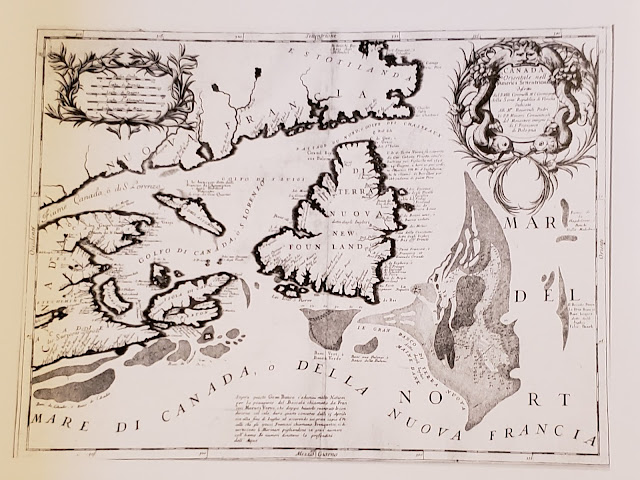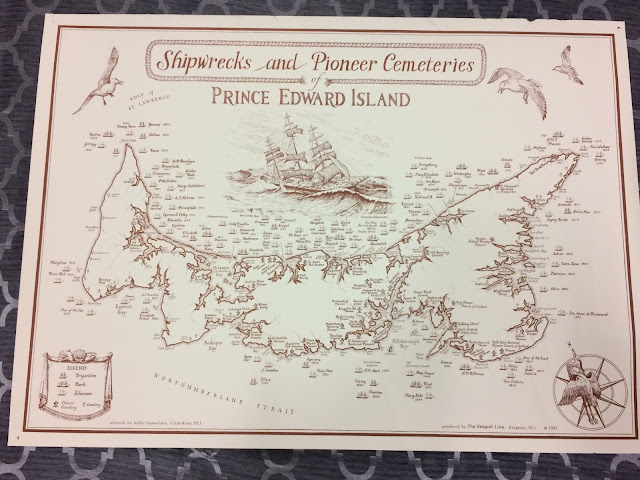The Great Name Change
PEI has had many names over the years. Today, we are going to look at why the Island went from being called Ile Saint-Jean to Prince Edward Island.
Ile Saint-Jean
PEI's first residents, the Mi'kmaq, called the Island Epekwitk, meaning "cradled on the waves." Europeans settlers pronounced it as Abegweit.
When Europeans arrived they gave the Island a different name - Ile Saint-Jean.
Interestingly, there is conflicting information about how the Island became Ile Saint-Jean. According to some sources like the Acadian Museum of Prince Edward Island and Prince Edward Island: An Illustrated History by Douglas Baldwin, it is unclear where this name came from. As Jacques Cartier (1535) believed the Island was part of the mainland, it is safe to say he did not name the Island. But, the first written record of this name came on a 1601 map. However, some believe the name could come from Saint John the Baptist as fishermen often stopped on the Island on/around June 24th, the Saint's holiday.
On the other hand, according to James W. MacNutt in The Historical Atlas of Prince Edward Island: The Way We Saw Ourselves, Giovanni Caboto, anglicized to John Cabot (1497), who discovered the Island for the Europeans named it Isle St. Jean because he "discovered" it on St. John's day (June 24th).
When the British took control of the Island they anglicized the name to St. John's Island.
St. John's Island
It remained St. John's Island until 1799 when it was renamed Prince Edward Island - named in honour of Prince Edward, the son of King George III.
But why? Why did they change the name?
It was changed for practical reasons, it was being confused for St. John's in Newfoundland and Saint John in New Brunswick. Plus, in the 1780s, there were at least eight rivers, ports, towns, etc, in the region called St/Saint John(s). It was getting confusing and understandably so! It was so bad, mail was going to the wrong places.
Fixing the Problem
To try to fix this problem, then Governor Walter Patterson and the Island government changed the Island's name to "New Ireland" - in honour of Patterson's homeland in the 1780s. But, the British vetoed this choice as another colony had already taken that name. The British suggested New Guernsey or New Anglesea. This time the Island government rejected the options.
In late November 1798, approval was given to Governor Edmund Fanning for the Island to be renamed Prince Edward Island. The official name change did not take place until 1799.
Why Prince Edward?
Why was St. John's Island renamed after Prince Edward?
During this period, Prince Edward (the son of King George III and future father of Queen Victoria) was stationed in Nova Scotia and Quebec with the British Army. He travelled the Maritimes but never made it to the Island - the one time he planned a trip here he was injured falling off a horse and the trip had to be cancelled.
But, Prince Edward did encourage more money to be dedicated to the defence of the Island. According to Nathan Tidridge, a biographer of Prince Edward, the Prince was the first person on record to use "Canadian" when referencing both the English and French. Usually, the term had only been used when referencing the French. To Prince Edward, using "Canadian" when referencing both the French and English was important in creating unity.
Interestingly, on H.A. Ashby's 1798 map of the Island, the Island was named Prince Edward Island and was the first map to use this name. If you look closely, this map also shows some of the settlement patterns.
Unknown to the Island, Prince Edward had suggested that the Island be joined with Nova Scotia. Author Douglas Baldwin has suggested, "If the government officials had known this fact, the province would probably not have its present name."
But the Island also had a desire to be closer to the crown, the evidence is found throughout the Island:
The Colonial Aspect
We cannot address the changing of the Island's name without looking at the colonial mindset.
We know the Mi'kmaq lived here long before European settlers and had their own name for the Island, Epekwitk. As you can imagine, they were not consulted when the Island became Ile Saint-Jean, St. John's Island, or Prince Edward Island.
Acadian Museum of Prince Edward Island. "Who named the Island "Isle Saint-Jean"? Why this name?" http://museeacadien.org/an/online-resources/frequently-asked-questions/du-nom-%C2%AB-ile-saint-jean-%C2%BB/
Baldwin, D.A. Prince Edward Island: An Illustrated History. Halifax: Nimbus Publishing, 2009.
MacNutt, J.A. The Historical Atlas of Prince Edward Island: The Ways We Saw Ourselves. Halifax: Formac Publishing Company Limited, 2009.
"Mapping the Discover and Development of Prince Edward Island." Island Imagined. http://www.islandimagined.ca/book/export/html/34
Sinclair, J. "How Prince Edward, who never set foot on PEI, ended up with an Island named after him." CBC News. November 2, 2017. https://www.cbc.ca/news/canada/prince-edward-island/pei-prince-edward-250-1.4382116
Ile Saint-Jean
PEI's first residents, the Mi'kmaq, called the Island Epekwitk, meaning "cradled on the waves." Europeans settlers pronounced it as Abegweit.
When Europeans arrived they gave the Island a different name - Ile Saint-Jean.
Interestingly, there is conflicting information about how the Island became Ile Saint-Jean. According to some sources like the Acadian Museum of Prince Edward Island and Prince Edward Island: An Illustrated History by Douglas Baldwin, it is unclear where this name came from. As Jacques Cartier (1535) believed the Island was part of the mainland, it is safe to say he did not name the Island. But, the first written record of this name came on a 1601 map. However, some believe the name could come from Saint John the Baptist as fishermen often stopped on the Island on/around June 24th, the Saint's holiday.
On the other hand, according to James W. MacNutt in The Historical Atlas of Prince Edward Island: The Way We Saw Ourselves, Giovanni Caboto, anglicized to John Cabot (1497), who discovered the Island for the Europeans named it Isle St. Jean because he "discovered" it on St. John's day (June 24th).
When the British took control of the Island they anglicized the name to St. John's Island.
St. John's Island
It remained St. John's Island until 1799 when it was renamed Prince Edward Island - named in honour of Prince Edward, the son of King George III.
But why? Why did they change the name?
It was changed for practical reasons, it was being confused for St. John's in Newfoundland and Saint John in New Brunswick. Plus, in the 1780s, there were at least eight rivers, ports, towns, etc, in the region called St/Saint John(s). It was getting confusing and understandably so! It was so bad, mail was going to the wrong places.
Fixing the Problem
To try to fix this problem, then Governor Walter Patterson and the Island government changed the Island's name to "New Ireland" - in honour of Patterson's homeland in the 1780s. But, the British vetoed this choice as another colony had already taken that name. The British suggested New Guernsey or New Anglesea. This time the Island government rejected the options.
In late November 1798, approval was given to Governor Edmund Fanning for the Island to be renamed Prince Edward Island. The official name change did not take place until 1799.
Why Prince Edward?
Why was St. John's Island renamed after Prince Edward?
During this period, Prince Edward (the son of King George III and future father of Queen Victoria) was stationed in Nova Scotia and Quebec with the British Army. He travelled the Maritimes but never made it to the Island - the one time he planned a trip here he was injured falling off a horse and the trip had to be cancelled.
But, Prince Edward did encourage more money to be dedicated to the defence of the Island. According to Nathan Tidridge, a biographer of Prince Edward, the Prince was the first person on record to use "Canadian" when referencing both the English and French. Usually, the term had only been used when referencing the French. To Prince Edward, using "Canadian" when referencing both the French and English was important in creating unity.
Interestingly, on H.A. Ashby's 1798 map of the Island, the Island was named Prince Edward Island and was the first map to use this name. If you look closely, this map also shows some of the settlement patterns.
 |
| HA Ashby's 1798 Map. (Image credit: Island Imagined) |
Unknown to the Island, Prince Edward had suggested that the Island be joined with Nova Scotia. Author Douglas Baldwin has suggested, "If the government officials had known this fact, the province would probably not have its present name."
But the Island also had a desire to be closer to the crown, the evidence is found throughout the Island:
- The three counties are Kings, Queens, and Prince
- Charlottetown was named after Queen Charlotte, the wife of King George III
- Georgetown was named after King George III
- Malpeque was once called Princetown
I am sure some of you can think of other examples.
The Colonial Aspect
We cannot address the changing of the Island's name without looking at the colonial mindset.
We know the Mi'kmaq lived here long before European settlers and had their own name for the Island, Epekwitk. As you can imagine, they were not consulted when the Island became Ile Saint-Jean, St. John's Island, or Prince Edward Island.
Acadian Museum of Prince Edward Island. "Who named the Island "Isle Saint-Jean"? Why this name?" http://museeacadien.org/an/online-resources/frequently-asked-questions/du-nom-%C2%AB-ile-saint-jean-%C2%BB/
Baldwin, D.A. Prince Edward Island: An Illustrated History. Halifax: Nimbus Publishing, 2009.
MacNutt, J.A. The Historical Atlas of Prince Edward Island: The Ways We Saw Ourselves. Halifax: Formac Publishing Company Limited, 2009.
"Mapping the Discover and Development of Prince Edward Island." Island Imagined. http://www.islandimagined.ca/book/export/html/34
Sinclair, J. "How Prince Edward, who never set foot on PEI, ended up with an Island named after him." CBC News. November 2, 2017. https://www.cbc.ca/news/canada/prince-edward-island/pei-prince-edward-250-1.4382116



Comments
Post a Comment